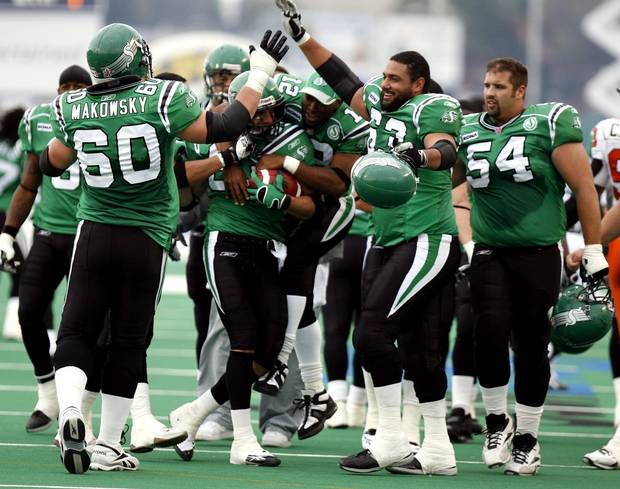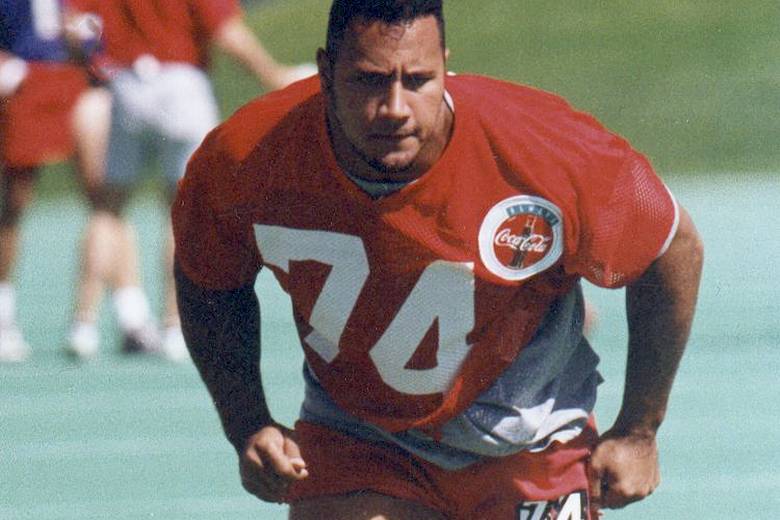Amy Dormuth and her husband Alex stood in the cold on the east side of Regina's Taylor Field for an hour and a half Friday. They were there to watch a demolition crew tear down the stadium's west grandstand – known as "the shady side" to Saskatchewan Roughriders fans. Hundreds of people joined the Dormuths. Scores more watched from rooftops throughout Regina. School kids watched it in class. The Canadian Forces Snowbirds flew over Taylor Field.
"One last hoorah for the old girl," said Amy Dormuth, who wore a Riders bunnyhug, which is what Saskatchewanians call a hooded sweatshirt that has a singular pocket at the belly and lacks a zipper. She surprised herself by not crying.
"There was no explosion at all. Just a crumple of metal and down it went. No kaboom at all," the 33-year-old fan said. "Just my heart exploded."
The shady side tipped forward, on to where the Riders used to play, at about 2:20 p.m. local time. Dust clouded the blue sky. "It didn't take as long to fall as I thought [it would], but it was also happening in slow motion," said Dormuth, who is part of a fan podcast.
The CFL team and its predecessors played on this patch of land full time for eight decades. Taylor Field had been on life support for years, its deficiencies addressed by patchwork, and even its death was prolonged as demo crews spent an extra hour and 20 minutes preparing for the collapse.
The shady side was 39 years old. It is survived by the sunny side on the field's eastern edge, although those stands are dying a slow death. The shady side was predeceased by its counterparts on the north and south sides of the open-air stadium.
Farewell, old friend.#RiderPride pic.twitter.com/kI5aq60zF1
— Sask. Roughriders (@sskroughriders) October 27, 2017
Taylor Field birthed and nurtured Rider Pride, populated by folks known for wearing watermelon helmets supporting the underdog.
Regina, knowing Rider Nation is fanatical, set up viewing areas for Friday's crash. The collapse took down a section that was 100 metres wide, 40 metres high, and 17 metres deep. Part of the shady side had already been removed.
The Riders' spiritual home has a permanent place in the country's history, recognized as one of Canada's most electrifying sports facilities. While Canada's broader population can, to some degree, understand Taylor Field's legacy, only Rider loyalists know that inside the gates, the stadium operated under a culture of segregation.
Roughriders fans are rightfully considered brainwashed maniacs, so in love with the Green and White that, in 2015, Insightrix Research Inc. determined the team's brand strength ranked third in the country, behind the Montreal Canadians and the Toronto Maple Leafs, respectively. To put that in context, the research firm noted Saskatchewan accounts for just 3 per cent of Canada's population.
Insightrix asked 2,700 sports fans questions about five topics: the first team that comes to mind; respect for the club; perception of most loyal fans; popularity; and the atmosphere of the team's home stadium or arena. The survey covered Canada's 21 professional sports teams.
Only 2.8 per cent of respondents mentioned the Roughriders when asked to rattle off the first three Canadian teams that came to mind. The Riders, however, gained ground in other categories. Roughly 12 per cent of the survey's participants believed the Riders had the most loyal fans, putting the team third behind the Habs and the Leafs. Taylor Field came in sixth when fans considered which arena or stadium had the best atmosphere. The survey's participants, however, assumed Taylor Field would finish third.
Where you sat in Taylor Field reflected your lot in life: how you perceived yourself and others, how much money you had, how much you were likely to drink. Taylor Field hosted a micro-society with a class system. And the west grandstand – with its back blocking the sun and wind and overhang shielding patrons in its highest benches from rain and snow – represented the top of the social pyramid.
A worker walks the perimeter prior to the west-side grandstand at Taylor Field during the deconstruction process.
Liam Richards/THE CANADIAN PRESS
Season ticket holders and folks with more disposable income gravitated to the shady side's 14,463 spots. Its constituents were calm, by Rider standards. The Dormuths called it Shady Pines. They preferred the eastern benches – known as the sunny side, which encompassed the university section and was known for its rowdiness. The sunny side's bleachers, on the visiting team's side of the field, were exposed to Saskatchewan's moody weather.
Suzanne White grew up in Regina and now lives in Canmore, Alta. As a kid, she considered the shady side lame. "It was the grown-up side," White said. "Fancy."
Her parents tried to restrict her to the grandstand when she was younger, but she strayed to the sunny side when she could get away with it. Now, at 43, the cycle of life has changed her attitude. "The sunny side would just be too intense. I'm too old. I'd be: 'Get off my lawn, you crazy kids.'"
Jeremy Powlowski reckons he has attended about 50 Rider games over his 41 years. He graduated to the shady side, which is behind the home team's bench, when he got his first "big boy job."
"Once you go there, it's hard to go back," Powlowski said. "Especially on a plus-40 day or a minus-40 day, the shady side was the only place to be."
The popular onion grill and whispers of culinary superiority helped fuel west-side righteousness. "Legend has it that the shady side had better food," said Powlowski, who now holds season tickets. "Like you could get perogies on the shady side but you couldn't get them on the sunny side."
Taylor Field's stratification extended beyond the east and west stands. Rowdies who procrastinated or couldn't afford to buy those tickets congregated in the Family Fun Zone's stands behind the north end zone. The stadium's undisputed gutter tickets were for Hemorrhoid Hill, behind the south end zone. No weather protection. No benches. Just ground. The football club only sold tickets there when demand outpaced supply. Translation: Hemorrhoid Hill was a staple at Labour Day Classics between the Roughriders and the Winnipeg Blue Bombers.
"You couldn't see anything so we would just sit there behind the CBC monitor … and we'd just watch the game on TV," White said. "But we were there."
Even fans who weren't on the edges of the Riders' rectangle were part of Taylor Field's seating system. Diehards with homes north of Taylor Field watched from their rooftops.

The Roughriders Andy Fontuz holds the ball he caught for a game-winning touchdown in overtime to beat the B.C. Lions as the rest of the team celebrates on Sunday Sept. 24, 2006 at Taylor Field.
Troy Fleece/The Canadian Press
Temporary seating made Taylor Field's capacity flexible and its record clocked in at 55,438 on Oct 14, 1995. Permanent seating came to the south around 2012, as part of Taylor Field's scatter-shot approach to upgrading the facility.
The Riders played their last home game at Taylor Field on Oct. 29, 2016, losing 24-6 to the B.C. Lions. Saskatchewan's community-owned football team now plays in a new $278.2-million stadium. The final price tag on the new digs, however, is expected to climb.
The Mosaic Co. bought the naming rights to Taylor Field in its final years and showed respect for the province's history by renaming it Mosaic Stadium at Taylor Field. The new facility is known simply as Mosaic Stadium. It holds 33,000 seats, with room to expand to 40,000.
Budget Demolition, which took down the Hamilton Tiger-Cat's Ivor Wynne Stadium in 2013, is in charge of Taylor Field's deconstruction. The stadium's demise is part of a larger vision for Regina. The deconstruction will create a 20-acre blank canvas, which the city hopes will fuel its future rather than nostalgia. The city envisions a revitalized mixed-use community within walking distance of Taylor Field's replacement. "We expect the plan to include a range of housing options to help meet the diverse needs of Regina's growing population while respecting the heritage of Regina's north central neighbourhood," the city's vision reads.
The entire bill for Taylor Field's deconstruction is $2.01-million, although fans offset this cost by paying a collective $80,000 for 14,500 square feet of turf and 880 benches. The Dormuths forked over $55 for their old bench and had to extract it themselves. They installed their spots – section 27, row 34, seats 6 and 7 – in their spare bedroom and sold the rest of the row to their fellow bench mates.
The Dormuths have season tickets in the new stadium, which provides weather protection to all despite its open roof. "The stadium is fabulous," Dormuth said. "I love it. You can flush all the toilets at the same time in the bathroom. There's hot running water in the bathroom."
But it doesn't feel like home yet. The demure culture in section 641 doesn't suit the Dormuths. They think it is populated by people who used to sit in Taylor Field's shady side.
"We're planning on moving next year," Dormuth said.
MORE FROM THE GLOBE AND MAIL:


